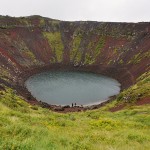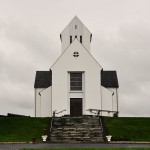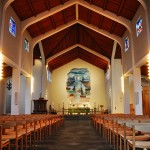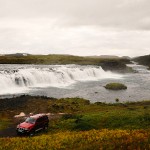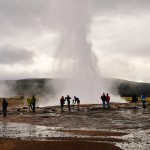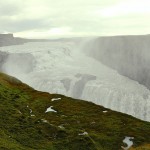We’ve been living in Iceland for more than six months now and in all this time we couldn’t really find the time, for a reason or another, to take part in more touristy activities, like going around to explore the country. The only serious travelling we did in Iceland was going from Seydisfjordur to Reykjavík when we arrived by boat back in February. It was an incredible experience, but definitely not enough.
Sometimes it’s impossible to find time to do things you want to do. If you expect time to generate itself just for your amusement and edification you will probably have to wait forever. That’s why we decided it was pointless to keep on delaying, waiting for the perfect moment to present itself.
With our friend Jason, in visit to Iceland from the US, we went to do the Golden Circle, a famous route that from the city of Reykjavík describes a loop of around 300 kilometers in lenght with some of Iceland’s most famous attractions along its itinerary. Kátur the dog was allowed to come too, becoming one of the few Icelandic canine excursionists the country has ever seen.
Treditionally, the Golden Circle’s first stop is the crater of Kerið, then a volcano and now a small lake. The crater is located in Grímsnes, also known as Iceland’s Western volcanic area. It is believed Kerið was originally a cone volcano which collapsed after exhausting its magma reserve. At approximately 3,000 years of age, Kerið is relatively young if compared to other volcanic formations present in the same area. The pool of water filling the bottom of crater, of a stunning turquoise color, contains high levels of minerals which are abundant in the soil.
We loved Kerið. The sunken pool of blue-green water was like an eye pointed to the silence of the overcast sky. The vivid reddish color of soil and rocks, contrasting with the bright green of the vegetation, created a truly unique picture. Kátur was particularly responsive to Kerið’s fascination. He drank a lot of the lake’s water and splashed all around its shores. He must have ruined quite a lot of photos other visitors were taking from the top of the crater. Unable to contain his excitement, he also nearly achieved to kill Harry by jumping on him, making him slip on the muddy ground.
Our next destination was Skálholt, an historical site that is considered one of the most important locations in Iceland. In Skálholt the first official school of Iceland was founded back in 1056. Skálholt’s school was aimed at educating clergymen as the site was, up to 1756 and along with Hólar in the North of the country, one of the only two Icelandic episcopal sees. Its importance as a cultural center granted Skálholt great vitality for many centuries.
We arrived in Skálholt as a huge tourism bus was leaving. After the crowd of tourists left, there was nobody around. The cathedral, standing lonely on its hill, looked particularly melancholic in the rain, but it also retained that incredible aura of gravity that only Northern churches can have. Coming from the Southern regions of Europe, Harry and I are more used to the decadence of Catholic cathedrals, with their impressive amounts of decorations and luxury. The Skálholtdómkirkja, with its semplicity and the clean appearance, looked a bit alien to us, but it also gave us a taste the spirituality that in more decadent churches is not easy to perceive. The small graveyard at the back of the building, so peaceful and green and facing the surroundings from above, created in our hearts a sense of longing and calmness it’s impossible to experience in the morbid embrace of Roman Catholic churches.
Peacefully grazing in the rain in the vicinity of the cathedral, a herd of cows entertained us for a good fifteen minutes. We offered them great entertainment as well. Well, not exactly us. Kátur alone did. The cows were terribly curious about the dog. They eagerly followed Kátur with their cute eyes for a long time, until their owner’s arrival made them change object of interest.
We left behind cows and church for the waterfall of Faxi soon after that. Faxi is a smaller waterfall on the Golden Circle route located along the course of the Tungufljót river. It’s also very close to the other two more famous stops of Geysir and Gullfoss. The waterfall is in fact quite small compared to other celebrated Icelandic waterfalls.
When we arrived at Faxi, there were only a couple of unauthorized fishermen. I say unauthorized because despite signs clearly stating fishing was forbidden they were indeed fishing. Sadly these things happen everywhere in the world, also in Iceland. I stayed away from the waterfall because waterfalls in general freak me out, while Harry and Jason, accompanied by Kátur, went close to water. At that point it wasn’t raining that hard, but my camera was very wet because of the waterfall’s sprays. I couldn’t take excellent photos, but I tried anyway.
After Faxi, we moved on to the next stop. Geysir and Strokkur are located in the Haukadalur valley, with just a few meters separating them. Geysir, the original geyser to which every other geyser in the world owes its name (the word geysir comes from the Old Norse word for gusher), sadly is not as active as it was in the distant past. For many years in a row the geyser remained entirely dormant. Earthquakes and human influence decreased its activity over the years and at the moment Geysir’s powerful eruptions of hot water cannot be appreciated more than three times a day. Strokkur, the other famous geyser in the area, in spite of its smaller size, is much more lively, erupting every five minutes or so. Visitors tend for this reason to gather around the reliable Strokkur to enjoy its frequent outbursts, while Geysir, once capable of impressive gushes reaching heights of more than 70 meters, lays most of the time forgotten in the background.
Our last stop was at Gullfoss, literally the golden waterfall. Located in the canyon of the river Hvítá, the waterfall is owned and protected by the Government to prevent its exploitation. Gullfoss is actually formed by two distinct waterfalls: the upper one with a drop of 11 meters and the second with a drop of 21 meters. The waters then plunge into a fissure that is 32 meters deep, making it look like they disappear into the abyss.
I already expressed my fear of waterfalls. Gullfoss looked terribly frightening to me. With its waters suddenly swallowed by the apparently bottomless crevice, it seemed like one of those intimidating views you see in XIX century paintings, with man as a negligible element at the mercy of natural forces. Kátur, usually so eager to explore, also felt unusually prudent in proximity of the rocks forming the waterfall’s precipice.
Since the weather was quite awful, with rain falling in buckets now and then, and since we couldn’t really force ourselves to wake up earlier in the morning, we decided to leave out Þingvellir’s National Park and include the smaller waterfall of Faxi, which isn’t usually among the “classic” and more famous Golden Circle stops. We are intentioned to spend a whole day at Þingvellir next week. Hopefully better weather will grace us in our upcoming expedition.
